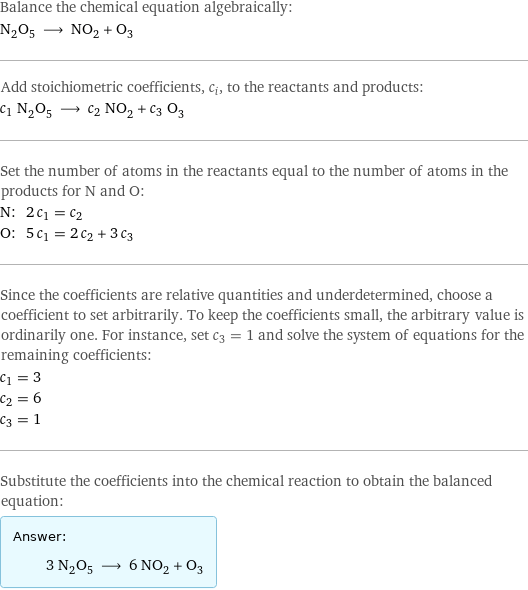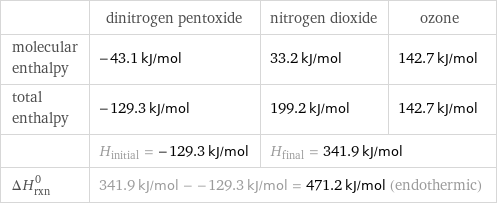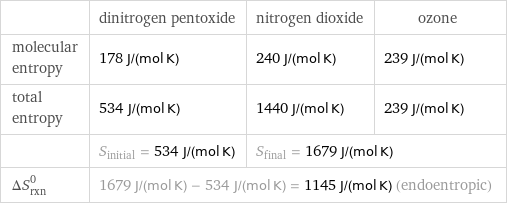Input interpretation

N_2O_5 dinitrogen pentoxide ⟶ NO_2 nitrogen dioxide + O_3 ozone
Balanced equation

Balance the chemical equation algebraically: N_2O_5 ⟶ NO_2 + O_3 Add stoichiometric coefficients, c_i, to the reactants and products: c_1 N_2O_5 ⟶ c_2 NO_2 + c_3 O_3 Set the number of atoms in the reactants equal to the number of atoms in the products for N and O: N: | 2 c_1 = c_2 O: | 5 c_1 = 2 c_2 + 3 c_3 Since the coefficients are relative quantities and underdetermined, choose a coefficient to set arbitrarily. To keep the coefficients small, the arbitrary value is ordinarily one. For instance, set c_3 = 1 and solve the system of equations for the remaining coefficients: c_1 = 3 c_2 = 6 c_3 = 1 Substitute the coefficients into the chemical reaction to obtain the balanced equation: Answer: | | 3 N_2O_5 ⟶ 6 NO_2 + O_3
Structures

⟶ +
Names

dinitrogen pentoxide ⟶ nitrogen dioxide + ozone
Reaction thermodynamics
Enthalpy

| dinitrogen pentoxide | nitrogen dioxide | ozone molecular enthalpy | -43.1 kJ/mol | 33.2 kJ/mol | 142.7 kJ/mol total enthalpy | -129.3 kJ/mol | 199.2 kJ/mol | 142.7 kJ/mol | H_initial = -129.3 kJ/mol | H_final = 341.9 kJ/mol | ΔH_rxn^0 | 341.9 kJ/mol - -129.3 kJ/mol = 471.2 kJ/mol (endothermic) | |
Gibbs free energy

| dinitrogen pentoxide | nitrogen dioxide | ozone molecular free energy | 113.9 kJ/mol | 51.3 kJ/mol | 163.2 kJ/mol total free energy | 341.7 kJ/mol | 307.8 kJ/mol | 163.2 kJ/mol | G_initial = 341.7 kJ/mol | G_final = 471 kJ/mol | ΔG_rxn^0 | 471 kJ/mol - 341.7 kJ/mol = 129.3 kJ/mol (endergonic) | |
Entropy

| dinitrogen pentoxide | nitrogen dioxide | ozone molecular entropy | 178 J/(mol K) | 240 J/(mol K) | 239 J/(mol K) total entropy | 534 J/(mol K) | 1440 J/(mol K) | 239 J/(mol K) | S_initial = 534 J/(mol K) | S_final = 1679 J/(mol K) | ΔS_rxn^0 | 1679 J/(mol K) - 534 J/(mol K) = 1145 J/(mol K) (endoentropic) | |
Equilibrium constant
![Construct the equilibrium constant, K, expression for: N_2O_5 ⟶ NO_2 + O_3 Plan: • Balance the chemical equation. • Determine the stoichiometric numbers. • Assemble the activity expression for each chemical species. • Use the activity expressions to build the equilibrium constant expression. Write the balanced chemical equation: 3 N_2O_5 ⟶ 6 NO_2 + O_3 Assign stoichiometric numbers, ν_i, using the stoichiometric coefficients, c_i, from the balanced chemical equation in the following manner: ν_i = -c_i for reactants and ν_i = c_i for products: chemical species | c_i | ν_i N_2O_5 | 3 | -3 NO_2 | 6 | 6 O_3 | 1 | 1 Assemble the activity expressions accounting for the state of matter and ν_i: chemical species | c_i | ν_i | activity expression N_2O_5 | 3 | -3 | ([N2O5])^(-3) NO_2 | 6 | 6 | ([NO2])^6 O_3 | 1 | 1 | [O3] The equilibrium constant symbol in the concentration basis is: K_c Mulitply the activity expressions to arrive at the K_c expression: Answer: | | K_c = ([N2O5])^(-3) ([NO2])^6 [O3] = (([NO2])^6 [O3])/([N2O5])^3](../image_source/4fa4f5c4bf694c95810dec1a301ad0df.png)
Construct the equilibrium constant, K, expression for: N_2O_5 ⟶ NO_2 + O_3 Plan: • Balance the chemical equation. • Determine the stoichiometric numbers. • Assemble the activity expression for each chemical species. • Use the activity expressions to build the equilibrium constant expression. Write the balanced chemical equation: 3 N_2O_5 ⟶ 6 NO_2 + O_3 Assign stoichiometric numbers, ν_i, using the stoichiometric coefficients, c_i, from the balanced chemical equation in the following manner: ν_i = -c_i for reactants and ν_i = c_i for products: chemical species | c_i | ν_i N_2O_5 | 3 | -3 NO_2 | 6 | 6 O_3 | 1 | 1 Assemble the activity expressions accounting for the state of matter and ν_i: chemical species | c_i | ν_i | activity expression N_2O_5 | 3 | -3 | ([N2O5])^(-3) NO_2 | 6 | 6 | ([NO2])^6 O_3 | 1 | 1 | [O3] The equilibrium constant symbol in the concentration basis is: K_c Mulitply the activity expressions to arrive at the K_c expression: Answer: | | K_c = ([N2O5])^(-3) ([NO2])^6 [O3] = (([NO2])^6 [O3])/([N2O5])^3
Rate of reaction
![Construct the rate of reaction expression for: N_2O_5 ⟶ NO_2 + O_3 Plan: • Balance the chemical equation. • Determine the stoichiometric numbers. • Assemble the rate term for each chemical species. • Write the rate of reaction expression. Write the balanced chemical equation: 3 N_2O_5 ⟶ 6 NO_2 + O_3 Assign stoichiometric numbers, ν_i, using the stoichiometric coefficients, c_i, from the balanced chemical equation in the following manner: ν_i = -c_i for reactants and ν_i = c_i for products: chemical species | c_i | ν_i N_2O_5 | 3 | -3 NO_2 | 6 | 6 O_3 | 1 | 1 The rate term for each chemical species, B_i, is 1/ν_i(Δ[B_i])/(Δt) where [B_i] is the amount concentration and t is time: chemical species | c_i | ν_i | rate term N_2O_5 | 3 | -3 | -1/3 (Δ[N2O5])/(Δt) NO_2 | 6 | 6 | 1/6 (Δ[NO2])/(Δt) O_3 | 1 | 1 | (Δ[O3])/(Δt) (for infinitesimal rate of change, replace Δ with d) Set the rate terms equal to each other to arrive at the rate expression: Answer: | | rate = -1/3 (Δ[N2O5])/(Δt) = 1/6 (Δ[NO2])/(Δt) = (Δ[O3])/(Δt) (assuming constant volume and no accumulation of intermediates or side products)](../image_source/57738428b9975b08a6d05da3285123bc.png)
Construct the rate of reaction expression for: N_2O_5 ⟶ NO_2 + O_3 Plan: • Balance the chemical equation. • Determine the stoichiometric numbers. • Assemble the rate term for each chemical species. • Write the rate of reaction expression. Write the balanced chemical equation: 3 N_2O_5 ⟶ 6 NO_2 + O_3 Assign stoichiometric numbers, ν_i, using the stoichiometric coefficients, c_i, from the balanced chemical equation in the following manner: ν_i = -c_i for reactants and ν_i = c_i for products: chemical species | c_i | ν_i N_2O_5 | 3 | -3 NO_2 | 6 | 6 O_3 | 1 | 1 The rate term for each chemical species, B_i, is 1/ν_i(Δ[B_i])/(Δt) where [B_i] is the amount concentration and t is time: chemical species | c_i | ν_i | rate term N_2O_5 | 3 | -3 | -1/3 (Δ[N2O5])/(Δt) NO_2 | 6 | 6 | 1/6 (Δ[NO2])/(Δt) O_3 | 1 | 1 | (Δ[O3])/(Δt) (for infinitesimal rate of change, replace Δ with d) Set the rate terms equal to each other to arrive at the rate expression: Answer: | | rate = -1/3 (Δ[N2O5])/(Δt) = 1/6 (Δ[NO2])/(Δt) = (Δ[O3])/(Δt) (assuming constant volume and no accumulation of intermediates or side products)
Chemical names and formulas

| dinitrogen pentoxide | nitrogen dioxide | ozone formula | N_2O_5 | NO_2 | O_3 name | dinitrogen pentoxide | nitrogen dioxide | ozone IUPAC name | nitro nitrate | Nitrogen dioxide | ozone
Substance properties

| dinitrogen pentoxide | nitrogen dioxide | ozone molar mass | 108.01 g/mol | 46.005 g/mol | 47.997 g/mol phase | solid (at STP) | gas (at STP) | gas (at STP) melting point | 30 °C | -11 °C | -192.2 °C boiling point | 47 °C | 21 °C | -111.9 °C density | 2.05 g/cm^3 | 0.00188 g/cm^3 (at 25 °C) | 0.001962 g/cm^3 (at 25 °C) solubility in water | | reacts | dynamic viscosity | | 4.02×10^-4 Pa s (at 25 °C) |
Units
